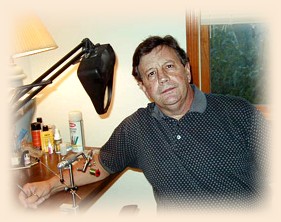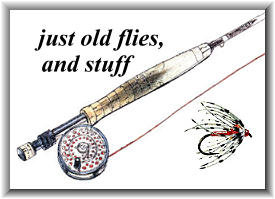This fly is one of a group of short-lived flies from
Ireland known as "maned" flies. The manes were made
of mohair tied along the top of the body, and the most
notable of the group was a fly called the Owenmore,
one I hope to bring to FAOL soon. The Beaconsfield is
attributed to George Blacklaws, in 1870, right around
the time these flies were popular.
I found the mohair somewhat difficult to work with, in
that it got caught up in nearly everything on the fly
from the hackle to the horns. Mohair tends to be "all
over the place" and it was difficult for me to tame. One
can consider these flies to be a precursor to our
modern-day hair-wings, and trust me; hair-wings are an
improvement, at least as far as manageability is concerned.
I like the stately look of the body on the Beaconsfield,
and it's one that I've always had in the back of my mind
to do. I never seemed to have the necessary colors of mohair
until I finally bought a selection from William Bailey in
Ft. Wayne, Indiana. Mr. Bailey does a wonderful job with
natural dying of various wool products, including pig's
wool, Berlin wool, and mohair, and his materials are a
full dress fly tier's dream.
I've endeavored to make a fly this time with a bit more
proportional wing than the last couple. The high wings
are a very American trend with these flies, and I'm very
American. Full dress flies have areas that tend to get
exaggerated over time. We've gone from the big high wings
now and graduated to the big fat bodies on a lot of these.
These are style trends that come and go over time. I've
looked at many antique flies and I for the life of me can't
find a standard there. Some DO have big fat bodies, some
very slender as Francis Francis recommended, some have
very low wings, and some have big high wings. I think
it comes down to doing what feels right for you, within
reason. If there are rules, and many feel there are, I'm
hard pressed to find them documented anywhere, at least
in the old books. Anyway, if you'd like a go at the
Beaconsfield and have some mohair kicking around,
here's the recipe:
The Beaconsfield
Tag: Silver tinsel and yellow floss.
Tail: A topping, teal and ibis.
Butt: Black herl, followed by two turns of
silver tinsel.
Body: In three equal parts: first and second
doubly butted; first part of yellow floss with a yellow
mane (mohair), black herl and two turns of silver tinsel.
Second: red-orange floss with a red-orange mane (mohair),
black herl and two turns of silver tinsel. Third: claret
floss.
Throat: Light blue hackle.
Wings: Two tippets, veiled with golden pheasant
tail, light and dark mottled turkey, bustard, teal, yellow,
red and blue swan; mallard and a topping.
Horns: Blue macaw.
Head: Black.
Credits: The Salmon Fly by George Kelson;
Classic Salmon Flies by Mikael Frodin,
~ EA
About Eric:
 I started fly fishing as a teen in and around my hometown
of Plattsburgh, New York, primarily on the Saranac River.
I started tying flies almost immediately and spent hours
with library books written by Ray Bergman, Art Lee, and
A. J. McClane. Almost from the beginning I liked tying
just as much as I liked fishing and spent considerable
time at the vise creating hideous monstrosities that
somehow caught fish anyway. Then one day I came upon a
group of flies that had been put out at a local drug store
that had been tied by Francis Betters of Wilmington, N.Y.
My life changed that day and so did my flies, dramatically.
Even though I never met Fran back then, I've always
considered him to be one of my biggest influences.
I started fly fishing as a teen in and around my hometown
of Plattsburgh, New York, primarily on the Saranac River.
I started tying flies almost immediately and spent hours
with library books written by Ray Bergman, Art Lee, and
A. J. McClane. Almost from the beginning I liked tying
just as much as I liked fishing and spent considerable
time at the vise creating hideous monstrosities that
somehow caught fish anyway. Then one day I came upon a
group of flies that had been put out at a local drug store
that had been tied by Francis Betters of Wilmington, N.Y.
My life changed that day and so did my flies, dramatically.
Even though I never met Fran back then, I've always
considered him to be one of my biggest influences.
I had a career in music for twenty years or so and didn't
fish much, though I did fish at times. The band I was with
had its fifteen seconds of fame when we were asked to be in
John Mellencamp's movie "Falling From Grace." I am the
keyboard player on the right in the country club scene in
the middle of the movie. Don't blink. It's on HBO all the
time. We got to meet big Hollywood stars and record in John's
studio. It was a blast.
So how did I wind up contributing to the Just Old Flies
column on FAOL? I'm not sure, it was something that I simply
wanted very badly to do, and they let me. Many of the old flies
take me back to the Adirondacs and my youth, and I guess I get
to relive some of it through the column. I've spent many happy
hours fishing and tying over the years, and tying these flies
brings back memories of great days on the water, and intense
hours spent looking at the flies in the fly plates in the old
books and trying to get my flies to look like them. And now,
here I am, still doing that to this day. ~ EA
|

 I started fly fishing as a teen in and around my hometown
of Plattsburgh, New York, primarily on the Saranac River.
I started tying flies almost immediately and spent hours
with library books written by Ray Bergman, Art Lee, and
A. J. McClane. Almost from the beginning I liked tying
just as much as I liked fishing and spent considerable
time at the vise creating hideous monstrosities that
somehow caught fish anyway. Then one day I came upon a
group of flies that had been put out at a local drug store
that had been tied by Francis Betters of Wilmington, N.Y.
My life changed that day and so did my flies, dramatically.
Even though I never met Fran back then, I've always
considered him to be one of my biggest influences.
I started fly fishing as a teen in and around my hometown
of Plattsburgh, New York, primarily on the Saranac River.
I started tying flies almost immediately and spent hours
with library books written by Ray Bergman, Art Lee, and
A. J. McClane. Almost from the beginning I liked tying
just as much as I liked fishing and spent considerable
time at the vise creating hideous monstrosities that
somehow caught fish anyway. Then one day I came upon a
group of flies that had been put out at a local drug store
that had been tied by Francis Betters of Wilmington, N.Y.
My life changed that day and so did my flies, dramatically.
Even though I never met Fran back then, I've always
considered him to be one of my biggest influences.